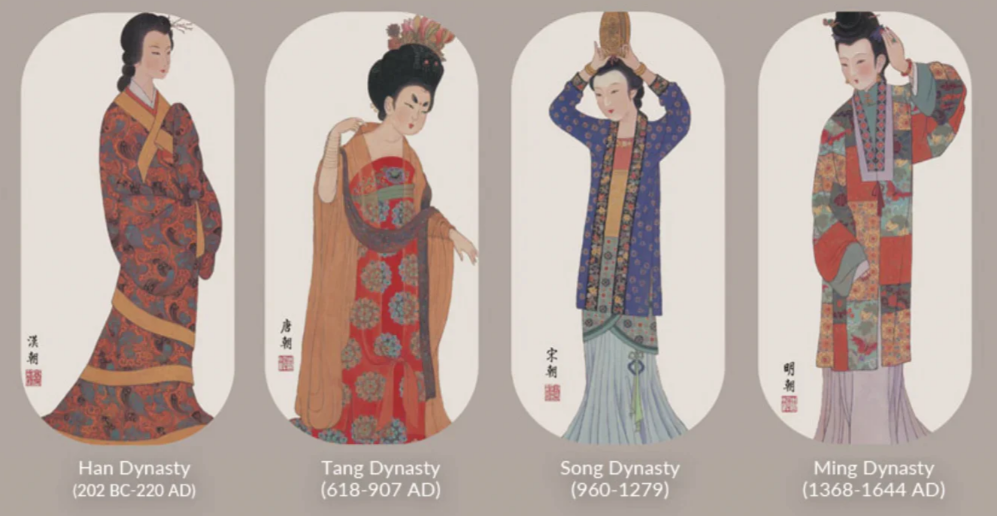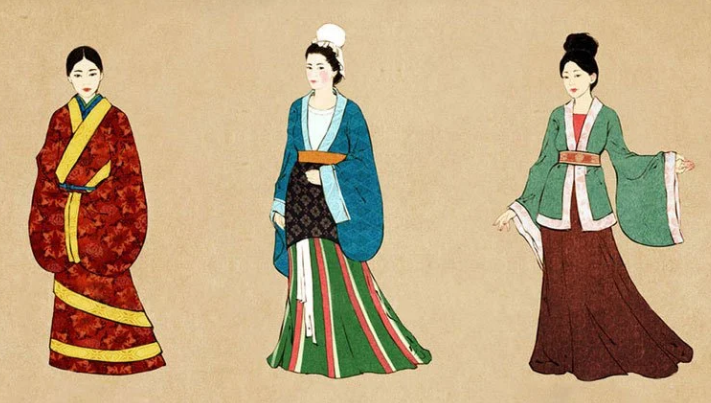Hanfu mirrors China’s history through its evolution in styles, materials, and symbolism across different dynasties, reflecting cultural and social changes.
Origins and Evolution of Hanfu
Early Development in Ancient Dynasties
The journey of Hanfu begins in the heart of ancient Chinese civilization. During the Neolithic period, people crafted garments primarily from animal skins and hemp fibers, setting the stage for Hanfu’s evolution. Progressing into the Xia, Shang, and Zhou dynasties, silk emerged as the cornerstone of Hanfu, thanks to the innovative discovery of sericulture. Significantly, the Zhou Dynasty introduced a hierarchical clothing system, where the colors and designs of Hanfu clearly delineated social status. This period firmly established Hanfu’s foundational style: a robe or shirt on the top, paired with a skirt or trousers below, all cinched together with a sash.
Influences of Silk Road on Hanfu Styles
With the opening of the Silk Road, a vital trade artery connecting East and West, Hanfu underwent a transformative phase. This era of exchange brought luxurious fabrics like brocades and damasks from distant lands, infusing Hanfu with new patterns and vibrant hues. More importantly, cross-cultural interactions sparked design innovations in Hanfu, integrating features such as Persian round collars and Central Asian motifs. This period underscored Hanfu’s unique ability to assimilate foreign influences while retaining its intrinsic Chinese essence.

Transformation During Successive Dynasties
As China journeyed through successive dynasties, Hanfu evolved, mirroring the nation’s cultural and historical shifts. The Tang Dynasty, renowned for its artistic and cosmopolitan flair, introduced wider sleeves and a palette of brighter colors, reflecting the era’s lavish and open-minded ethos. Conversely, the Song Dynasty favored refined elegance, leading to simpler and less ornate Hanfu designs. The Ming Dynasty marked a return to traditional styles, with straight lines and symmetrical silhouettes, a cultural response to the preceding Mongol-led Yuan Dynasty. This continuous evolution of Hanfu not only signifies shifts in fashion but also symbolizes the enduring dynamism and resilience of Chinese culture across centuries.
Symbolism and Cultural Significance
Representations of Social Status and Ethnic Identity
Hanfu, more than just clothing, serves as a vivid tapestry of China’s social and ethnic history. Each dynasty’s unique Hanfu style eloquently articulated the wearer’s social rank and ethnic identity. For instance, during the Tang Dynasty, officials wore Hanfu with distinctively colored belts, signifying their rank in the bureaucracy. Emperors and high-ranking officials often adorned their robes with dragon motifs, symbolizing supreme power and authority. In contrast, commoners were restricted to simpler, unembellished Hanfu, reinforcing the social hierarchy. Ethnic diversity within China also influenced Hanfu styles, with different regions incorporating unique elements into their attire, thus creating a rich mosaic of cultural identity. The Hanfu’s ability to convey such intricate social and ethnic narratives underscores its profound cultural significance.
Rituals and Ceremonies
Hanfu’s role in rituals and ceremonies is deeply rooted in Chinese tradition, embodying respect and reverence for cultural practices. Ceremonial Hanfu, often more ornate and elaborate, plays a pivotal role in life’s significant events, from weddings to funerals. During traditional Chinese weddings, brides and grooms wear specially designed Hanfu, reflecting the gravity and sanctity of the matrimonial bond. Likewise, during the Lunar New Year and other festivals, Hanfu becomes a garment of celebration, often adorned with auspicious symbols to attract good fortune and ward off evil spirits. In ancestral worship and other Confucian ceremonies, Hanfu symbolizes a connection to the past, honoring ancestors and the continuity of family lineage.
Symbolic Motifs and Their Historical Meanings
The motifs and patterns embroidered or woven into Hanfu are not mere decorations; they are a language of symbolism, conveying messages and values held dear in Chinese culture. Common motifs like the lotus, phoenix, and dragon each have rich symbolic meanings. The lotus represents purity and enlightenment, often seen in Hanfu worn for religious or spiritual occasions. The phoenix, a symbol of grace and virtue, is frequently associated with femininity and often adorns women’s Hanfu. The dragon, emblematic of strength and good fortune, is traditionally reserved for the Emperor’s Hanfu, illustrating his divine right to rule. These motifs, woven into the fabric of Hanfu, serve as a visual narrative of China’s historical values and beliefs, making each garment a piece of living history.
Hanfu in Dynastic Eras
Han Dynasty
The Han Dynasty stands as a pivotal era in the history of Hanfu, giving this traditional attire its name and establishing its status as a cultural icon. During this period, Hanfu evolved into a system of dress that included the Shenyi, a robe that integrated the upper garment and the lower skirt. This innovation symbolized unity and was considered the epitome of Hanfu design. Silk, owing to advancements in sericulture, became the predominant fabric, reflecting the dynasty’s prosperity and technological progress. The Han Dynasty’s Hanfu was marked by its simplicity, elegance, and practicality, mirroring the Confucian ideals of modesty and propriety. Emphasizing a balanced silhouette and fluid lines, it set a standard for traditional Chinese attire that subsequent dynasties would follow and modify.
Ming Dynasty
The Ming Dynasty heralded a renaissance in Hanfu design, blending tradition with innovation. This era saw the revival of ancient Hanfu styles, particularly those from the Tang Dynasty, known for their flamboyance and diversity. Ming Dynasty Hanfu distinguished itself with vibrant colors, intricate embroidery, and the widespread use of cotton alongside silk. Designers of this era experimented with various sleeve styles and collar designs, adding layers and complexity to the Hanfu. The introduction of wide sleeves and the use of multiple layers of clothing reflected the Ming Dynasty’s aesthetic of grandeur and magnificence. This period’s contributions to Hanfu were significant, as they encapsulated a blend of respect for tradition with a boldness to innovate, setting a precedent for future generations.
Qing Dynasty
With the Qing Dynasty, Hanfu experienced a dramatic transformation under the influence of Manchu styles. The Manchu rulers introduced the Changshan and Qipao (Cheongsam), which gradually integrated into Han Chinese fashion. Unlike the loose and flowing Hanfu of previous dynasties, Qing Dynasty attire was more form-fitting and straight-lined, reflecting Manchu aesthetic values. The use of horsehoof-shaped cuffs and the stand-up collar were distinct features of this era’s attire. This period witnessed a fusion of Han and Manchu clothing styles, symbolizing the blending of different cultural elements under the Qing rule. Despite initial resistance, these styles eventually gained acceptance and became an integral part of Chinese clothing culture, illustrating the dynamic nature of cultural exchange and adaptation.
| Feature | Han Dynasty | Ming Dynasty | Qing Dynasty |
|---|---|---|---|
| Style | Shenyi, integrated upper and lower garment | Revival of Tang styles, wide sleeves | Influence of Manchu styles, form-fitting |
| Fabric | Silk predominance, introduction of cotton | Vibrant colors, intricate embroidery, silk and cotton | Horsehoof cuffs, stand-up collars |
| Symbolism | Unity, Confucian ideals of modesty | Grandeur, blend of tradition and innovation | Cultural fusion, Manchu influence |
| Impact | Set standard for traditional Chinese attire | Added complexity and layers to Hanfu | Integrated Han and Manchu fashion |
This table offers a comparative overview of Hanfu across three significant dynasties, highlighting their unique contributions to the evolution of this iconic Chinese garment. Each dynasty not only influenced the style and design of Hanfu but also reflected broader cultural and social dynamics of the period.

Contemporary Resurgence and Historical Reflection
Revival Movements in Modern China
The Hanfu revival movement, gaining momentum in the early 21st century, marks a significant resurgence of traditional Chinese attire in modern China. This movement, driven by a growing sense of national pride and cultural identity among the younger generations, advocates for the return of Hanfu as a daily wear option. Online platforms and social media have played a pivotal role in this resurgence, enabling enthusiasts to share designs, organize Hanfu events, and educate the public about its history. The movement is not just about clothing; it represents a broader interest in traditional Chinese culture, including tea ceremonies, classical literature, and Confucian philosophies. The revival of Hanfu goes beyond fashion, embodying a deeper desire to reconnect with and celebrate a rich cultural heritage.
Hanfu as a Reflection of Chinese Cultural Heritage
Hanfu, in its intricate designs and patterns, serves as a living canvas that reflects the rich tapestry of Chinese cultural heritage. Each element of Hanfu, from the fabric to the embroidery, tells a story of historical significance. For instance, the use of silk speaks to China’s ancient sericulture and its pivotal role in the global Silk Road trade. Motifs like dragons, phoenixes, and lotuses symbolize various virtues and beliefs central to Chinese culture. The revival of Hanfu has also reignited interest in traditional arts and crafts, leading to a resurgence in skills like silk weaving and embroidery. Hanfu is not just attire; it is a symbol of Chinese civilization’s continuity, ingenuity, and artistic legacy.
The Role of Hanfu in Contemporary Chinese Identity
In contemporary China, Hanfu transcends its role as a traditional garment to become a symbol of national identity and cultural pride. It allows individuals, especially the youth, to express a connection to their ancestral roots in a modern context. Wearing Hanfu becomes a statement of cultural awareness and a form of personal and collective expression. This phenomenon has also influenced global perceptions of Chinese culture, showcasing its depth and diversity beyond the stereotypical representations. The embrace of Hanfu in popular culture, including in films, television shows, and festivals, has reinforced its relevance and appeal to a broader audience. Hanfu, thus, plays a critical role in shaping and expressing contemporary Chinese identity, bridging the past with the present and the future.
Through these detailed explorations, it becomes evident that the contemporary resurgence of Hanfu is more than a fashion trend; it’s a movement reflecting historical pride, cultural heritage, and a strong sense of identity among modern Chinese people.